
Starlings are small to medium-sized passerine birds in the family Sturnidae. The Sturnidae are named for the genus Sturnus, which in turn comes from the Latin word for starling, sturnus. The family contains 128 species which are divided into 36 genera. Many Asian species, particularly the larger ones, are called mynas, and many African species are known as glossy starlings because of their iridescent plumage. Starlings are native to Europe, Asia, and Africa, as well as northern Australia and the islands of the tropical Pacific. Several European and Asian species have been introduced to these areas, as well as North America, Hawaii, and New Zealand, where they generally compete for habitats with native birds and are considered to be invasive species. The starling species familiar to most people in Europe and North America is the common starling, and throughout much of Asia and the Pacific, the common myna is indeed common.

The mynas are a group of birds in the starling family (Sturnidae). This is a group of passerine birds which are native to southern Asia, especially India, Pakistan, Bangladesh, Nepal and Sri Lanka. Several species have been introduced to areas like North America, Australia, South Africa, Fiji and New Zealand, especially the common myna, which is often regarded as an invasive species.

The spotless starling is a passerine bird in the starling family, Sturnidae. It is closely related to the common starling, but has a much more restricted range, confined to the Iberian Peninsula, Northwest Africa, southernmost France, and the islands of Sicily, Corsica and Sardinia. It is largely non-migratory.

The jungle myna is a myna, a member of the starling family. It is found patchily distributed across much of the mainland of the Indian Subcontinent but absent in the arid zones of India. It is easily recognized by the tuft of feathers on its forehead that form a frontal crest, a feature also found in the closely related Javan myna and the pale-bellied myna which were treated as a subspecies in the past. The eyes are pale, yellow or blue depending on the population and the base of the orange-yellow bill is dark. It has also been introduced either intentionally or accidentally into many other parts of the world including Fiji, Taiwan, the Andaman Islands, and parts of Japan. The species has also spread out on its own to some islands in the Pacific.

The brahminy starling or brahminy myna is a member of the starling family of birds. It is usually seen in pairs or small flocks in open habitats on the plains of the Indian subcontinent.

The white-faced starling is a member of the starling family of birds. It is an endemic resident breeder in Sri Lanka.
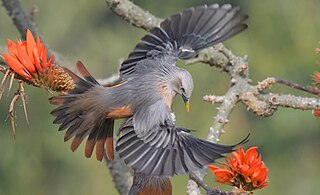
The chestnut-tailed starling, also called grey-headed starling and grey-headed myna is a member of the starling family. It is a resident or partially migratory species found in wooded habitats in India and Southeast Asia. The species name is after the distribution of a former subspecies in the Malabar region. While the chestnut-tailed starling is a winter visitor to peninsular India, the closely related resident breeding population with a white head is now treated as a full species, the Malabar starling.
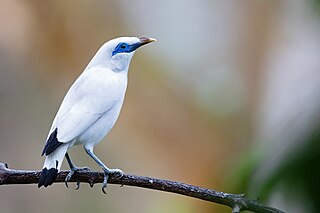
The Bali myna, also known as Rothschild's mynah, Bali starling, or Bali mynah, locally known as jalak Bali, is a medium-sized, stocky myna, almost wholly white with a long, drooping crest, and black tips on the wings and tail. The bird has blue bare skin around the eyes, greyish legs and a yellow bill. Both sexes are similar. It is critically endangered and in 2020, fewer than 50 adults were assumed to exist in the wild.

The Indian pied myna is a species of starling found in the Indian subcontinent. It is usually found in small groups mainly on the plains and low foothills. It is often seen within cities and villages although it is not as bold as the common myna. It produces a range of calls made up of liquid notes.
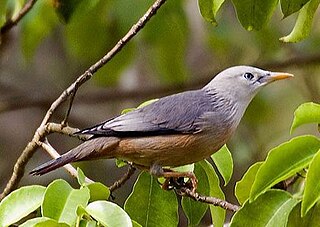
The Malabar starling is a species of starling found in southwestern India. It was previously considered a subspecies of the chestnut-tailed starling.
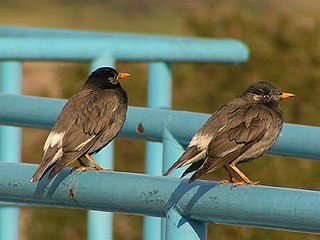
The white-cheeked starling or grey starling is a passerine bird of the starling family. It is native to eastern Asia where it is a common and well-known bird in much of its range.

The bank myna is a myna found in the northern parts of South Asia. It is smaller but similar in colouration to the common myna, only differing in having brick-red naked skin behind the eyes instead of yellow. It is greyer on the underside and in this and in the presence of a slight tuft of feathers bears some resemblance to the jungle myna. They are found in flocks on the plains of northern and central India, often within towns and cities. Their range appears to be extending southwards into India. The name is derived from their habit of nesting almost exclusively in the earthen banks of rivers, where they excavate burrows and breed in large colonies.

The white-headed starling, also known as the Andaman white-headed starling, is a species of starling in the family Sturnidae. It is found in wooded habitats of the Andaman and Nicobar Islands.

The black-collared starling is a species of starling in the family Sturnidae. Its plumage is black and white, with a black collar. It is found in southern China and most of mainland Southeast Asia, and has been introduced to Taiwan, Malaysia and Singapore. Its habitats include grassland, dry forest and human settlements. The International Union for Conservation of Nature (IUCN) has assessed it as being of least concern.
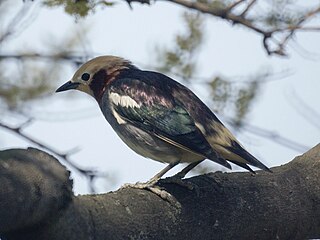
The chestnut-cheeked starling is a species of starling in the family Sturnidae. It breeds in Japan and the Russian islands of Sakhalin and Kuriles; it winters in Taiwan, the Philippines and northern Borneo.

The red-billed starling is a species of starling in the family Sturnidae. It is found in south and southeastern China.

The white-shouldered starling is a species of bird in the starling family Sturnidae. It breeds in southern China and northern Vietnam; it winters in Southeast Asia.

The Daurian starling, or purple-backed starling, is a species of bird in the starling family found in the eastern Palearctic from eastern Mongolia and southeastern Russia to North Korea and central China.

Sturnia is a genus of Asian birds in the starling family Sturnidae. It is sometimes merged with Sturnus.

Agropsar is a genus of Asian birds in the family Sturnidae. It is sometimes merged with Sturnus or Sturnia




















